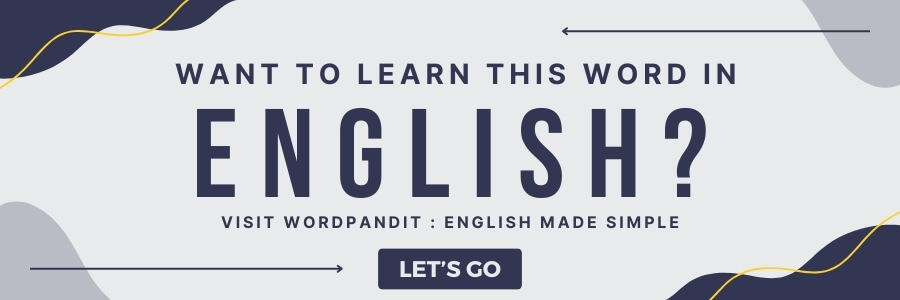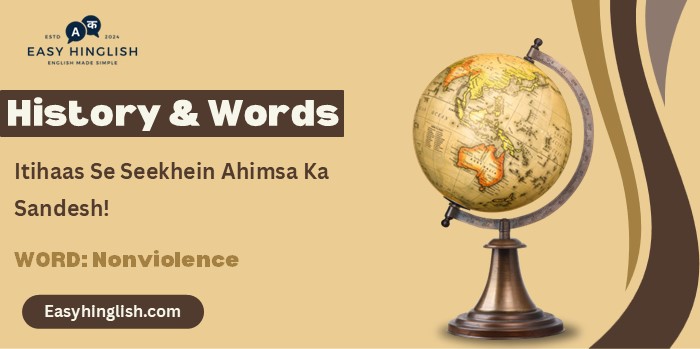History & Words: 'Nonviolence' (October 2)
Welcome to 'History & Words.' Main Prashant hoon, Wordpandit aur Learning Inc. Network ka sansthapak. Yeh series meri bhasha seekhne ki lagan aur itihas ke prati ruchi ka sangam hai. Har kadi ek shabd aur uss se judi ek tithi par roshni daalti hai, jisse aapka shabdkosh badhta hai aur aap itihas ko gehraai se samajh paate hain. Aaiye, iss safar mein shabdon ke madhyam se samay mein pichhe chalein.
🔍 Aaj ka Shabd: Nonviolence
Pronunciation: /nɒnˈvaɪələns/ (non-VAY-uh-luhns)
🌍 Parichay (Introduction)
October 2, 1869 ko Gujarat ke Porbandar me ek chhota sa bachcha paida hua tha, jiska naam tha Mohandas Karamchand Gandhi. Kaun jaanta tha ki yeh bachcha ek din pure world ko ek revolutionary concept sikhayega – 'Nonviolence' ka power. Aaj, October 2nd ko hum International Day of Non-Violence ke roop me celebrate karte hain, UN ki taraf se 2007 me officially declare kiya gaya.
Gandhi ka 'Ahimsa' ka philosophy sirf ek political strategy nahi thi, balki ek complete way of life thi. Unka belief tha ki violence se violence hi paida hoti hai, lekin nonviolence truth aur justice ki foundation hai. Yeh concept itna powerful tha ki isse influence lekar Martin Luther King Jr., Nelson Mandela, aur countless other leaders ne apne struggles me use kiya.
'Nonviolence' aaj sirf ek word nahi hai – yeh ek powerful tool hai jo oppression, injustice, aur conflict ko resolve karne ke liye use hota hai. Gandhi ne dikhaaya ki kaise bina weapons ke, sirf moral strength aur peaceful resistance se ek empire ko hila diya ja sakta hai.
🌱 Shabd ka Utpatti (Etymology)
"Nonviolence" shabd ka construction simple hai lekin profound meaning hai:
✅ "Non-" (prefix jo negation ya absence ko denote karta hai)
✅ "Violence" (jo Latin shabd "violentia" se aaya hai, meaning "force" ya "injury")
Interestingly, Gandhi khud English me "nonviolence" shabd use karte the, lekin unka original concept Sanskrit shabd "Ahimsa" par based tha. "Ahimsa" Sanskrit me "a" (not) + "himsa" (violence/harm) se bana hai. Gandhi ne is ancient Indian philosophy ko modern political action ka form diya.
Western philosophy me "nonviolence" as a systematic approach relatively new concept hai, though peaceful resistance ke examples history me kahin milte hain. Gandhi ne isse "Satyagraha" (truth-force) ke naam se popularize kiya.
📖 Mahatvapurn Shabdavali (Key Vocabulary)
- 🔑 Ahimsa: Sanskrit term for nonviolence, meaning "to do no harm" – physically, mentally, ya emotionally
- 🔑 Satyagraha: Gandhi ka term for nonviolent resistance, literally meaning "truth-force" ya "holding onto truth"
- 🔑 Civil Disobedience: Unjust laws ko peacefully disobey karna to bring about change
- 🔑 Passive Resistance: Nonviolent opposition to authority, especially government policies
- 🔑 Moral Authority: Power jo ethical principles aur integrity se aata hai, rather than force se
🏛️ Itihasik Sandarbh (Historical Context)
Nonviolence ka concept ancient hai – Buddhism, Jainism, aur Hinduism me ahimsa ek fundamental principle hai. Lekin isse systematic political tool ke roop me use karna Gandhi ka contribution hai. 19th century me, when European colonialism apne peak par thi, traditional rebellion methods often brutal suppression face karte the.
Gandhi ne South Africa me 1893-1915 tak apna first experiments kiye nonviolent resistance ke saath. Yahan unhone racial discrimination ke against fight kiya aur "Satyagraha" ki foundation rakh di. Unka approach revolutionary tha – instead of fighting fire with fire, woh moral superiority establish karte the.
India me Gandhi ki return 1915 me hui, aur 1920s se unka mass movements start hue. Khilafat Movement, Non-Cooperation Movement, Salt March (Dandi March) 1930 me – ye sab nonviolent resistance ke classic examples ban gaye. British government ko pehli baar ehsaas hua ki traditional suppression methods Gandhi ke moral authority ke against ineffective hain.
World War II ke time Gandhi ka "Quit India Movement" 1942 me ek turning point tha. Despite massive arrests aur suppression, movement ka moral force eventually British ko India chhodne par majboor kar diya. 1947 me Independence mil gayi, jo nonviolent struggle ki biggest victory thi.

⏳ Samayrekha (Timeline)
- 1869: Mahatma Gandhi ka birth, October 2nd ko Porbandar me
- 1893: Gandhi South Africa pahunche, racial discrimination experience kiya
- 1906: Pehla Satyagraha campaign South Africa me launch kiya
- 1915: Gandhi India wapas aaye
- 1920: Non-Cooperation Movement start kiya
- 1930: Salt March (Dandi March) – iconic nonviolent protest
- 1942: Quit India Movement launch kiya
- 1947: Indian Independence – nonviolent struggle ki victory
- 1948: Gandhi ki assassination, January 30th ko
- 1955–1968: Martin Luther King Jr. ne US Civil Rights Movement me nonviolence use kiya
- 2007: UN ne October 2nd ko International Day of Non-Violence declare kiya
🌟 Is Din ka Mahatva (The Day's Significance)
October 2nd ka significance multilayered hai. Pehle toh yeh Mahatma Gandhi ka birthday hai – us vyakti ka jo modern nonviolence philosophy ka architect maana jaata hai. Lekin iska deeper meaning yeh hai ki yeh day pure humanity ko remind karta hai ki conflicts ko resolve karne ke peaceful ways exist karte hain.
UN General Assembly ne 2007 me unanimously is day ko International Day of Non-Violence declare kiya. Yeh decision significant tha because it represented global recognition of Gandhi's philosophy aur iska contemporary relevance. Is day ka purpose hai "education aur public awareness about nonviolence."
Gandhi ka approach revolutionary isliye tha ki unhone nonviolence ko weakness nahi, balki greatest strength ke roop me present kiya. Unka famous quote tha: "Nonviolence is not a garment to put on and off at will. Its seat is in the heart, and it must be an inseparable part of our being."
Is din ko worldwide, schools, universities, aur organizations various programs organize karte hain jo peace education, conflict resolution, aur human rights awareness promote karte hain. India me toh yeh Gandhi Jayanti ke roop me national holiday hai.
💬 Prasiddh Ukti (Quote)
"Nonviolence is a weapon of the strong. With the weak it might easily be hypocrisy." — Mahatma Gandhi
🔮 Aaj Ka Matlab aur Chintan (Modern Usage and Reflection)
Aaj ke digital age me 'nonviolence' ka concept aur bhi relevant ho gaya hai. Social media pe hate speech, cyberbullying, aur online harassment ke against nonviolent approaches develop ho rahe hain. Climate change movements, human rights activism, aur social justice campaigns me Gandhi ke principles ko adapt kiya ja raha hai.
Modern interpretations me nonviolence sirf physical violence se abstain karna nahi hai – yeh emotional violence, psychological harm, aur structural violence ko bhi address karta hai. Restorative justice systems, which focus on healing rather than punishment, nonviolent principles par based hain.
Current global conflicts me mediators aur peace-builders nonviolent communication techniques use karte hain. Corporate world me bhi conflict resolution ke liye Gandhi ke approaches adopt kiye jaa rahe hain.
🏛️ Virast (Legacy)
Gandhi ka nonviolence philosophy ka impact immeasurable hai. Martin Luther King Jr. ne American Civil Rights Movement me iska successful application kiya. Nelson Mandela ne South African apartheid ke against fight me Gandhi ke methods use kiye. Dalai Lama, Aung San Suu Kyi (controversies se pehle), aur countless other leaders ne nonviolent resistance adopt kiya.
Academic level par, Peace Studies aur Conflict Resolution as disciplines establish hue hain jo largely Gandhi ke philosophy par based hain. Numerous universities me Gandhi Studies centers hain jo nonviolence research promote karte hain.
Legal systems me bhi changes aaye hain – many countries ne truth and reconciliation commissions establish kiye hain instead of purely punitive justice systems. Yeh approach nonviolent conflict resolution ka example hai.
🔍 Tulnatmak Vishleshan (Comparative Analysis)
Gandhi ke time me nonviolence ko often passive resistance samjha jaata tha, lekin modern understanding me yeh highly active aur strategic approach hai. Earlier, critics used to say that nonviolence only works against "civilized" opponents like British, but later movements ne prove kiya ki yeh brutal dictatorships ke against bhi effective ho sakta hai.
Contemporary nonviolence movements technology ka extensive use karte hain – social media campaigns, viral videos, aur digital organizing tools. Yeh Gandhi ke time me available nahi tha, but core principles same remain karte hain: moral authority, mass participation, aur strategic planning.
Modern conflicts me hybrid approaches develop hue hain jo traditional nonviolence ko legal advocacy, international pressure, aur economic sanctions ke saath combine karte hain.
💡 Kya Aapko Pata Hai? (Did You Know?)
🎓 Antim Vichar (Conclusion)
October 2nd sirf calendar ka ek date nahi hai – yeh humanity ko yaad dilata hai ki change possible hai bina violence ke. Gandhi ka nonviolence philosophy today's world me aur bhi relevant hai jab conflicts global scale par exist karte hain aur weapons increasingly destructive ho rahe hain.
Nonviolence ka message simple hai lekin practice karna challenging: hate ko love se, violence ko peace se, aur injustice ko truth se counter karna. Yeh approach sirf conflicts resolve nahi karti, balki lasting peace aur understanding build karti hai.
📚 Aage Padhne Ke Liye (Further Reading)
- 📖 "The Story of My Experiments with Truth" – Mahatma Gandhi
- 📖 "Stride Toward Freedom" – Martin Luther King Jr.
- 📖 "The Politics of Nonviolent Action" – Gene Sharp








